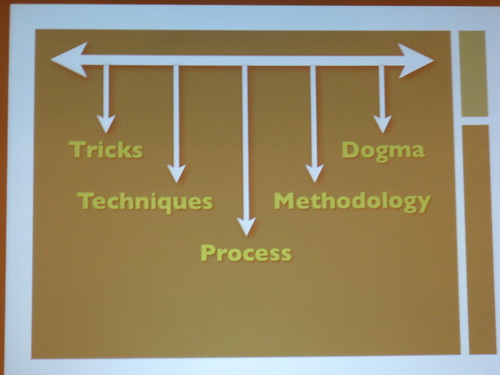Jared Spool did the opening keynote presentation early this morning at IA Summit 2008. His talk, titled Journey to the Center of Design, was funny enough to keep us awake and provocative enough to keep us listening.
He opened it up by flatly stating:
“User-centered design has never worked.”
He went on to talk about the mild feud that’s brewing between the boys at 37signals and Don Norman. I had linked to these sites last month, when Norman asked the question, “Why is 37signals so arrogant?” in response to an article in Wired Magazine in which the guys made no apologies when they said that they don’t design their products for their users, but rather design for themselves. They defended themselves, of course.
It’s becoming popular to design without user research; Apple didn’t do any primary research while designing the iPod. But as 37signals pointed out, it’s not the goal that they disagree with, but the method. Jared helps make a necessary distinction between the following terms:

- Dogma is “unquestioned faith independent of any supporting evidence”
- Methodology is the repeatable process, whether it be ad hoc or formalized
- Process is the steps necessary to get something done.
- Techniques are the skilled ways of performing each step, and once mastered can be used in a variety of situations)
- Tricks are the techniques you use not for purpose they were intended
The research at UIE has found that the best teams don’t have a steadfast methodology or dogma that they follow. Instead the best teams focused on increasing the number of techniques and tricks in their toolbox, constantly exploring new possibilities.
To illustrate his point, Jared conducted an impromptu “brand engagement study” with a selection of audience members. Before his talk started, he asked 30 people (me included) if they would be willing to fill out a survey and participate. We were asked 11 questions about our feelings towards four brands: Starbucks, McDonalds, Apple and Microsoft. We had to rate each statement on “Don’t Agree,” “Neither” or “Agree.” Then for each brand we tallied up all of the columns and subtracted the sum of “Don’t Agrees” from the sum of “Agrees,” equaling a number between -11 and 11 that represented our affinity toward the brand. When he called us to the front of the room during his talk, we were told to stand by our number pasted on the wall as he called out each of the brands. In essence, we created a human bar chart. No one was surprised to see that the curve for Apple was skewed positively while Microsoft was skewed negatively.
The elaborate display was meant to demonstrate that information about customers can be gleaned in limitless and unique ways (new techniques) that are in service to the ultimate goal.
“It’s time we replace the User-Centered Design dogma”
Instead the focus should be on “informed design” to create usable and desirable experiences. He proposes the three core UX attributes:
- solid vision
- strong capability for getting feedback
- and culture for doing this kind of work
“Organizations that succeed spend at least 2 hours every 6 weeks watching people who use their products.”
Furthermore, your organization must have the culture to accept and even reward failure:
“In the last 6 weeks, have you rewarded a team member for really fucking up?…Good judgment comes from experience and experience comes from bad judgment”
Thanks to Jared for not being afraid to say what many of us are already thinking, and for giving us a way to articulate it.
Slides here:
Related Posts:
- User Centered Design is now closed February 18, 2009 | 3 comments
- UX Bookshelf July 19, 2008 | 11 comments
- Web 2.0 Expo NY: “10 Tips for Creative Environments” with Adaptive Path’s Bryan Mason and Sarah Nelson September 20, 2008 | 1 comments
- Empathy is the Core of Design Thinking February 26, 2013 | 2 comments
- IA Summit 2009: A functional family reunion March 29, 2009 | 2 comments




Great recap. Adds lots of missing context from tweetstream! There has to be an ‘early adopter’ angle to this thinking. I’ve been screaming same for years…and immediate colleagues think I’m insane. But then most of them are still reeling from pride over their CUA Certification. I refused to drink their Kool-Aid.
This is so refreshing to see. Part of what wasn’t clicking at my last job was that nobody was realizing the importance of having a vision to rally around. When I tried to develop that vision, the culture worked against me; but when I followed their direction and backed off, suddenly nobody knew what to do.
I think those are three valuable points, and I definitely think that is where our field is going. I’ll make sure to keep them in mind.
Well written! Very informative!
Interestingly, Tom Fishburne has a similar take on Jared’s chart shown above.
http://tomfishburne.typepad.com/